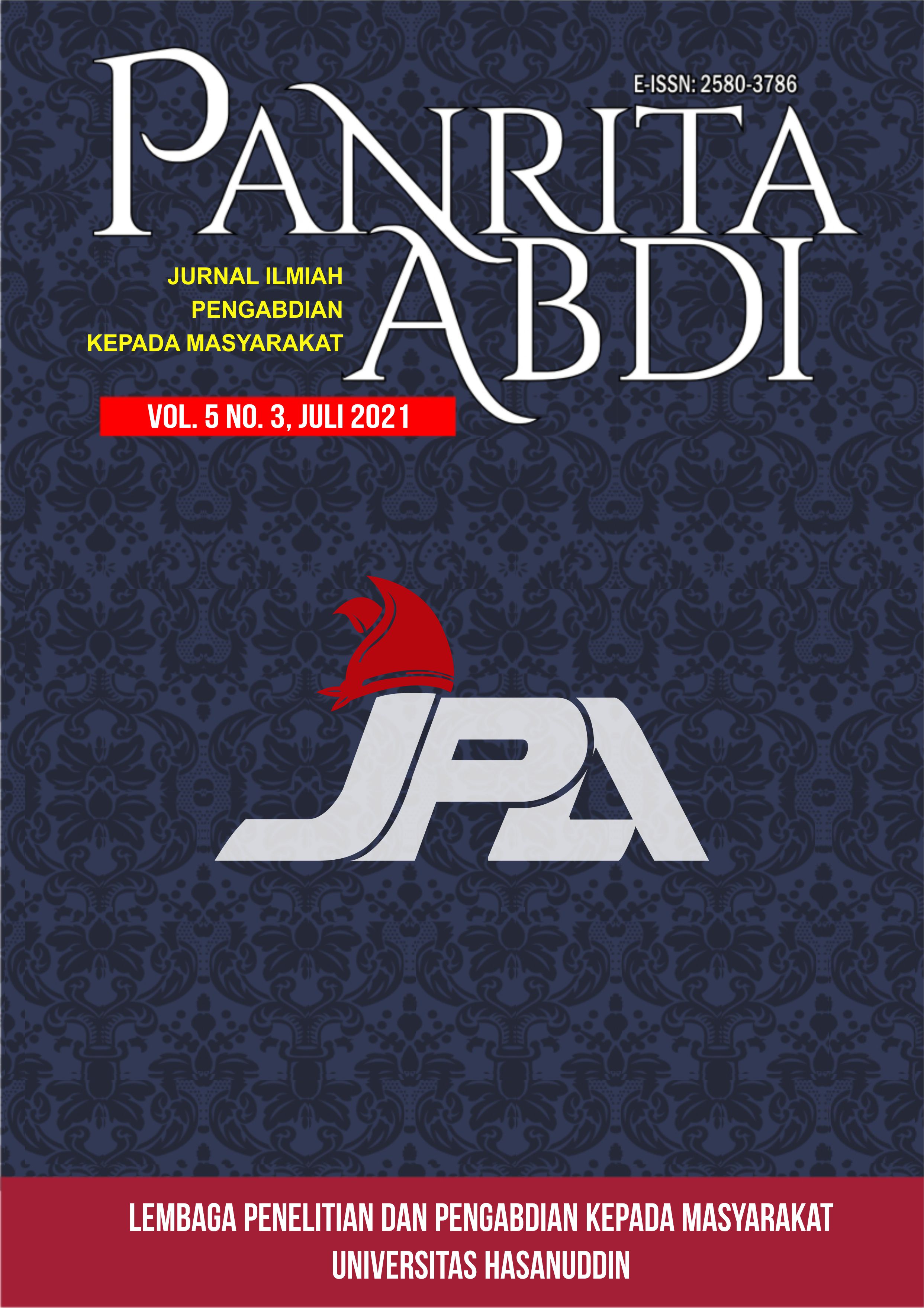PEMANFAATAN INSTALASI PENGOLAHAN LIMBAH UNTUK MEREDUKSI LIMBAH BERBAHAYA PADA TEMPAT PEMBUANGAN AKHIR ANDOOLO
Keywords:
Landfill, leachate, waste treatment plant, assistanceguidanceAbstract
Abstract. Leachate is a liquid that infiltrates through rubbish heaps due to direct rain fall, drainage water, or water from the surrounding area and has extracted dissolved or suspended material. Leachate contains pollutants with very high concentration so that it is potential to pollute the environment. Waste treatment installation system is one solution. Waste treatment in this service uses a pool system. The problem is the limited understanding of the community/construction workers around the landfill regarding the method of making a good and correct waste treatment plant (IPL). The application of science and technology in this service is carried out with a model of assistance/ guidance on how to make a good box system of IPL so that hazardous waste from the landfill can be minimized as much as possible. The results show that assistance/guidance on how to make IPL at the landfill site adds insight into the community/construction workers around the landfill in making the IPL. They have better understood and explored the process of making a good IPL so that it can function properly in tackling pollution of the soil, water, and the surrounding environment. The process of meeting the quality standards has been recorded properly so that the construction implementation process can run more smoothly. With the assistance/guidance given, they are able to be independent individually and in groups to develop their careers in the future as construction workers, especially in making IPL. Leachate treatment units applied are anaerobic ponds, facultative pools, maturation ponds and constructed wetlands.
Abstrak. Lindi merupakan cairan yang menginfiltrasi melalui tumpukan sampah akibat air hujan secara langsung, air drainase, atau air dari area sekitar dan telah mengekstraksi material terlarut maupun tersuspensi. Lindi mengandung polutan dengan konsentrasi sangat tinggi sehingga sangat potensial untuk mencemari lingkungan. Sistem instalasi pengolahan limbah merupakan salah satu solusi. Pengolahan limbah dalam pengabdian ini menggunakan system kolam. Permasalahannya adalah terbatasnya pemahaman masyarakat/para pekerja bangunan di sekitar TPA tentang metode pembuatan instalasi pengolahan limbah (IPL) yang baik dan benar. Penerapan iptek dalam pengabdian ini dilaksanakan dengan model pendampingan/bimbingan tentang cara pembuatan IPL sistem kotak yang baik sehingga limbah berbahaya hasil TPA bisa diminimalisir semaksimal mungkin. Hasil menunjukkan bahwa pendampingan/ bimbingan tentang cara pembuatan IPL di lokasi TPA menambah wawasan masyarakat/ pekerja bangunan sekitar TPA dalam membuat IPL. Mereka telah lebih memahami dan mendalami proses pembuatan IPL yang baik sehingga dapat berfungsi sebagaimana mestinya dalam menanggulangi pencemaran tanah, air dan lingkungan sekitar. Proses pemenuhan baku mutu sudah terekam dengan baik sehingga proses pelaksanaan konstruksi bisa berjalan lebih mulus. Dengan pendampingan/bimbingan yang diberikan, mereka sudah bisa mandiri secara personal maupun kelompok untuk mengembangkan karirnya ke depan sebagai pekerja bangunan/konstruksi khususnya pembuatan IPL. Unit-unit pengolahan limbah/lindi TPA yang diterapkan adalah kolam anaerobik, kolam fakultatif, kolam maturasi dan constructed wetland.
References
Al-Wabel, M.I., Al Yehya, W.. S., Al-Farraj, A.S., and El-Maghraby. 2011. Characteristics of Landfill Leachates and Bio-Solids of Municipal Solid Waste ( MSW ) in Riyadh City , Saudi Arabia. Journal of the Saudi Society of Agricultural Sciences, 10(2): 65–70. King Saud University & Saudi Society of Agricultural Sciences. doi:10.1016/j.jssas.2011.03.009.
Carabali-Rivera, Y.S., Barba-Ho, L.E., and Torres-Lozada, P. 2017. Determination of Leachate Toxicity through Acute Toxicity using Daphnia Pulex and Anaerobic Toxicity Assays. Ingenieria E Investigacion, 37(1): 16–24. doi:10.15446/ing.investig.v37n1.54220.
Devri, A. 2003. Pengelolaan Leachate Di Tempat Pembuangan Akhir (TPA) Tompogunung.
Friadi, Y., Marsudi, and Yusuf, W. (n.d.). Desain Instalasi Pengolahan Leachate (IPL) di TPA Entikong Kabupaten Sanggau.
Jin-zhu, C., Zhi-bin, D., and Yong-ping, N. 2011. Design and Commissioning of the Landfill Leachate Treatment Project In Ju-Rong City. Procedia Environmental Sciences, 10: 464–470. Elsevier Ltd. doi:10.1016/j.proenv.2011.09.076.
Kumar, S.S., Krishna, A.M., and Dey, A. 2017. Evaluation of dynamic properties of sandy soil at high cyclic strains. Soil Dynamics and Earthquake Engineering, 99. doi:10.1016/j.soildyn.2017.05.016.
Purwanta, W. 2007. Tinjauan Teknologi Pengolahan Leachate di Tempat Pembuangan Akhir (TPA) Sampah Perkotaan. Jurnal Air Indonesia, 3(1): 57–63.
Said, N.I., and Hartaja, D.R.K. 2015. Pengolahan Air Lindi dengan proses Biofilter Anaerob-Aerob dan Denitrifikasi. Jurnal Air Indonesia, 8(1).
Saleh, C. 2012. Studi Perencanaan Instalasi Pengolahan Limbah Lindi Sebagai Kontrol Pemenuhan Baku Mutu sesuai Kepmen 03/91. Jurnal Teknik Pengairan, 10(2): 87–94.
Saleh, C., and Purnomo, H. 2014. Analisis Efektifitas Instalasi Pengolahan Limbah Lindi di TPA Supit Urang Kota Malang. Jurnal Teknik Pengairan, 5(1): 103–109.
Sari, R.N., and Afdal. 2017. Karakteristik Air Lindi ( Leachate ) di Tempat Pembuangan Akhir Sampah Air Dingin Kota Padang. Jurnal Fisika Unand, 6(1): 93–99.
Selvan, S.K., Palanivel, M., Jayakumar, R., and Jennifer, S.A. 2016. Environmental Impact Analysis of Physico chemical Characterization of Landfill leachate from Municipal Solid Waste ( MSW ) dump yard in Dharapuram Town, Tamil Nadu, India. International Research Journal of Environment Sciences, 5(1): 13–20.
Usman, S., and Santosa, I. 2014. Pengolahan Air Limbah Sampah (Lindi) dari Tempat Pembuangan Akhir Sampah (TPA) Menggunakan Metoda Constructed Wetland. Jurnal Kesehatan, 5(2): 98–108.
Yatim, E.M., and Mukhlis. 2013. Pengaruh Lindi (leachate) Sampah Terhadap Air Sumur Penduduk Sekitar Tempat Pembuangan Akhir (TPA) Air Dingin. Jurnal Kesehatan Masyarakat, 7(2): 54–59.
Downloads
Published
Issue
Section
License
Copyright (c) 2021 Panrita Abdi - Jurnal Pengabdian pada Masyarakat

This work is licensed under a Creative Commons Attribution-NonCommercial-NoDerivatives 4.0 International License.








